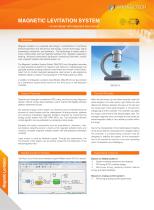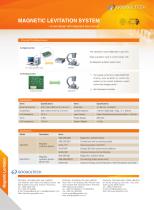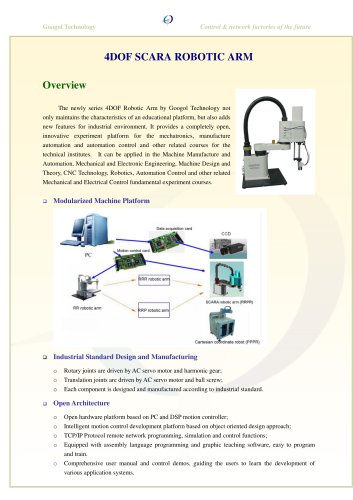
Catalog excerpts

Magnetic Levitation System metsyS noitativeL citengaM -- A new design with integrated laser sensor Overview Magnetic levitation is a classical technology in mechatronics. It combines electromagnetism and electronics technology, control technology, signal processing, mechanics, and dynamics. The technology is widely used in many industry elds such as magnetic levitation train, magnetic suspension bearing, miniature transmission equipment, measuring instrument, robotic wrist, magnetic levitation educational system, etc. The Magnetic Levitation System (Model: GML2001) from Googoltech provides an ideal experiment platform for research and tutorial for undergraduate and graduate students studying classical control theory and modern control theory. Apart from its modern designed appearance, laser sensor is also applied as feedback signal to measure moving distance of the oating ball accurately. In addition, the Magnetic Levitation body (Model: GML2001A) can be provided as a standalone experimental device for any third party or self-designed controller. System Features Students can thoroughly comprehend PID tuning, root locus tuning, frequency domain method tuning, status feedback control method with Matlab software platform experiment course. Via optional analog control system, by observing and comprehending the structure of control system and the characteristic of driving module, students can construct embedded magnetic levitation controller by combining the analog control system with DSP, ARM, MCU, etc. The embedded discrete control algorithm can be perfected by comparing control results. Students can select components such as photoelectric, ultrasonic, infrared distance detecting sensor to build up the magnetic levitation body; and construct complete magnetic levitation system with self-designed embedded controller. Laser sensor is used as feedback signal. Through the experiments, the non-linearity of the system can be directly viewed by the distribution of the electromagnetic eld. Magnetic Levitation Matlab Control Interface Use Root Locus Control as an example (support Matlab version 2012b or above): Control Principle When the ball moves up and down vertically under the electromagnet, the laser sensor right below the ball detects the distance between the apex of the ball and the lowest part of the electromagnet. It converts the voltage signal to the controller. The controller calculates the output current level of the electromagnet coils. The emerged magnetic force can levitate the ball under the electromagnetic stably in any arbitrary position within the range. Due to the characteristic of the mathematical modeling of the device that the composed unit is unstable without the controller, a corresponding controller must be designed to stabilize the system. As the linearization has to be carried out around a non-zero operating point, it is therefore very challenging. Experiment contents Based on Matlab platform: ※ System modeling experiment and analysis; ※ PID tuning & PID controller design; ※ Root locus tuning, frequency domain method tuning, and status feedback. Based on analog control system: ※ PID tuning & analog control experiments.
Open the catalog to page 1
Magnetic Levitation System metsyS noitativeL citengaM -- A new design with integrated laser sensor Control Configurations (I) Digital Control The standard model (GML2001) uses PCI Data acquisition card to communicate with the Magnetic levitation system drive. GML2001 PC + Data acquisition card 1. The analog control box model GAES1001 directly uses amplifier to control the system by two control schemes: current control and voltage control. 2. Self developed controller. Specifications Items Body Dimensions Core Size Control Distance Coil Resistance Laser Sensor Class 2 Red Semiconductor...
Open the catalog to page 2All Googol Technology (HK) Limited catalogs and technical brochures
-
GMPPC-1201-BT0001
4 Pages
-
XYZ Stage
3 Pages
-
XY Table
3 Pages
-
Self-Balancing Robot
2 Pages
-
SCARA Robotic Arm
4 Pages
-
Magnetic Levtitaiton System
2 Pages
-
Linear Inverted Pendulum
3 Pages
-
Four-Rotor Hover Vehicle
3 Pages
-
DC Servo Control Trainer
3 Pages
-
6DOF Robotic Arm
2 Pages
-
3DOF Helicopter Simulator
2 Pages
-
CB10L
2 Pages
-
EC-B01_Robot Controller
1 Pages
-
EC-C01_Robot Controller
1 Pages
-
iDEABOX 3 CPU
6 Pages
-
Fieldbus Cables
2 Pages
-
Fieldbus Connectors
4 Pages
-
Modbus I/O Modules
5 Pages
-
Profinet I/O Modules
6 Pages
-
CANopen I/O Modules
8 Pages
-
EtherCAT I/O Modules
6 Pages
-
Profibus – DP I/O Modules
10 Pages
-
GTDD Servo Drive
2 Pages
-
GTHD Servo Drive
2 Pages
-
Motion Control Panel PC
4 Pages
-
GE Series Motion Controllers
13 Pages
-
Ball & Beam control system
3 Pages
-
GUS Series motion controller
2 Pages
-
GT Series Motion Controllers
13 Pages
-
Softlink 300 PLC System
18 Pages
-
Educational Products
48 Pages








































































